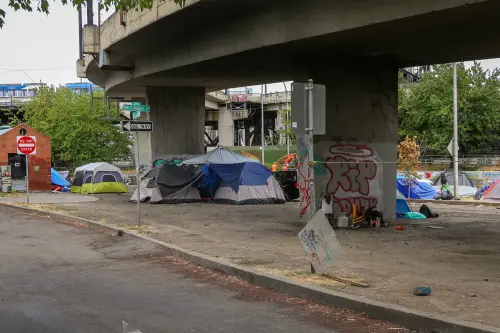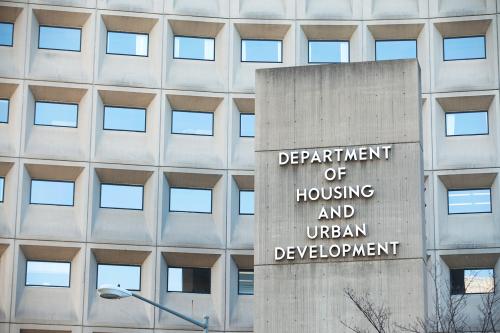Congress has begun debating the reauthorization of welfare, and President Bush has made his preference clear: He wants a New York City workfare-type program to become the national model.
Back in 1998, then-Mayor Rudolph W. Giuliani announced that every adult or head of household still on the rolls in the year 2000 would be working for a welfare check. He hired Jason Turner, then-Wisconsin Gov. Tommy Thompson’s welfare administrator, to accomplish this task for New York City. In an attempt to achieve the mayor’s goal, Turner created the largest workfare program in the country.
Under the Turner program, recipients first attended a 30-day job-search program. If, by the program’s end, they hadn’t found jobs, they were placed in workfare positions created by the city, doing things like cleaning parks and subways. Most assignments did not require or develop marketable skills. Many welfare recipients who were in education programs were forced to quit school in order to fulfill the work requirement. The program sparked lawsuits over whether workfare participants were entitled to health and safety protections, and there is fairly strong evidence that the program displaced many paid city employees.
On their face, the numbers out of the New York program looked good. Since 1996, New York City’s welfare caseloads have declined by 50%. Almost immediately, tightened regulations kept many applicants off the rolls. By late 1998, only 25% of those seeking welfare were found eligible, a marked decrease from the time of Mayor David N. Dinkins, when 75% of applicants qualified. But the success of a welfare program cannot be judged by caseload numbers alone, and the Giuliani administration consistently refused to release the kind of data that would make rigorous analysis and evaluation possible. Little is known about long-term employment outcomes of participants, nor about what has happened to people who were forced to leave the rolls.
Still, when his deadline for all welfare recipients working neared in late 1999, Giuliani proclaimed the program’s success. This despite the fact that when members of the city council and the press analyzed what little data were available, they found that only about 15% of the caseload was actually participating in workfare.
What were the other recipients doing? Some were waiting for the city to give them a work assignment, and nearly 30% were unavailable for work because of bad health. Many others were working in the private sector, but earning so little they were still eligible for welfare assistance.
Research elsewhere in the country also raises questions about the effectiveness of workfare. In Washington state, where more than one model was tried, a transitional program that paid actual wages to participants had a positive impact on their later earnings. The New York City-style work-for-welfare model, though, was ineffective. The state ultimately discontinued the workfare program after evaluating its results.
But the lack of evidence to support New York City’s strategy hasn’t kept it from being a focal point of federal policymaking.
Today, Turner is a favorite on the congressional hearing circuit, where he prescribes the New York City model as the right plan for the rest of the country. Thompson is President Bush’s Secretary of Health and Human Services. Turner’s top aide in New York, Andrew Bush, directs the Health and Human Services office that administers welfare block grants. And the president’s plan for welfare reauthorization, “Working Toward Independence,” bears a strong resemblance to New York City’s workfare program.
While welfare caseloads in most states began to rise last year as the economy weakened, the overall caseload decline since federal welfare reform in 1996 is dramatic, with millions of former recipients now working. Over time, the vast majority of welfare recipients do work, and most of them leave welfare altogether. Still, welfare exists in part to ensure the health and safety of families when the head of household is unable to work temporarily. Thus, it is the nature of churning welfare caseloads that at any time a large number of people are not working because they are waiting for assignments, caring for sick children, lacking transportation or any one of a long list of legitimate reasons.
The Bush proposal sets an impossible standard for states to meet. It is estimated that only 30% of those now on welfare in New York City—in the program that serves as a model for the administration—would qualify under the narrow guidelines in the administration’s proposal.
The president’s proposal isn’t about helping welfare recipients get and keep good jobs. As welfare rolls have declined, less than half the money flowing to states for welfare is being spent on welfare checks. As recipients have transitioned to work, more is being spent on child care, transportation and training—supports that can help people achieve long-term independence. If states have to spend resources on creating make-work jobs for a New York-style program, such supports will collapse.
State and local officials have made it clear they prefer to maintain—even increase—their flexibility in deciding whether recipients are making progress toward work. In California, state officials, responding to a survey by the National Governors Assn., said the president’s proposal would “significantly limit state flexibility to design programs that move families from welfare to work.” Moreover, additional work requirements—and the additional child care they will necessitate—won’t come cheap. Last week, the nonpartisan California legislative analyst’s office reported that the state would have to spend an addition $2.8 billion over the next five years to implement the proposed workfare program—tough news in the face of a projected $15 billion state-budget shortfall. The state’s survey response added a plea to federal policymakers: “Resist the urge to fix what isn’t broken.”
By last count, one-third of the remaining national caseload was in just 10 urban counties. Local officials in those places need and want a menu of options to help families help themselves. They want the flexibility to invest in training, child care and transportation, so poor parents will be able to leave welfare and poverty for good.
Los Angeles County officials are among those opposing the new work mandates in the president’s proposal, estimating implementation would cost $257 million. The county’s chief administrative officer, David E. Janssen, told supervisors that the victims of the proposal would be children and families.
In New York City, Commissioner Verna Eggleston, Mayor Michael Bloomberg’s new head of the Human Resources Administration, has a similar perspective. In recent testimony, she said, “HRA needs maximum flexibility from federal and state levels to allow us to tailor our programs to meet the needs of our clients, where our clients are…. It is clear that the ‘one-size-fits-all’ approach to service delivery will not work.”
Unfortunately, some members of Congress are marching to the president’s tune—a lack of evidence to support his proposal notwithstanding. The march is a fast one, too. House Republicans moved last week to pass legislation that includes the Bush workfare model, and they hope to have a vote before the end of May. The Senate plans to begin hearings before Memorial Day. A bill must be passed and signed by the president before the current law expires at the end of September.
Congress should listen to local program operators and state officials—not the architects of the president’s proposal, who seem to be promoting what they think they implemented in New York City, not what actually happened there. And not what the numbers show us is needed there—or anywhere.



Commentary
Op-edNew York Program Wrong Model for U.S.
April 21, 2002